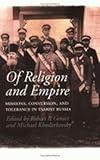Of Religion and Empire : Missions, Conversion, and Tolerance in Tsarist Russia / ed. by Robert Geraci, Michael Khodarkovsky.
Material type: TextPublisher: Ithaca, NY : Cornell University Press, [2018]Copyright date: ©2001Description: 1 online resource (368 p.) : 14 halftones, 1 mapContent type:
TextPublisher: Ithaca, NY : Cornell University Press, [2018]Copyright date: ©2001Description: 1 online resource (368 p.) : 14 halftones, 1 mapContent type: - 9781501724305
- 200/.947 22
- online - DeGruyter
| Item type | Current library | Call number | URL | Status | Notes | Barcode | |
|---|---|---|---|---|---|---|---|
 eBook
eBook
|
Biblioteca "Angelicum" Pont. Univ. S.Tommaso d'Aquino Nuvola online | online - DeGruyter (Browse shelf(Opens below)) | Online access | Not for loan (Accesso limitato) | Accesso per gli utenti autorizzati / Access for authorized users | (dgr)9781501724305 |
Browsing Biblioteca "Angelicum" Pont. Univ. S.Tommaso d'Aquino shelves, Shelving location: Nuvola online Close shelf browser (Hides shelf browser)

|

|

|

|

|

|

|
||
| online - DeGruyter Virtue Ethics, Old and New / | online - DeGruyter Gothic Reflections : Narrative Force in Nineteenth-Century Fiction / | online - DeGruyter Window on the East : National and Imperial Identities in Late Tsarist Russia / | online - DeGruyter Of Religion and Empire : Missions, Conversion, and Tolerance in Tsarist Russia / | online - DeGruyter The Pride of Place : Local Memories and Political Culture in Modern France / | online - DeGruyter The Betrayal of Local 14 : Paperworkers, Politics, and Permanent Replacements / | online - DeGruyter Keepers of the Revolution : New Yorkers at Work in the Early Republic / |
Frontmatter -- Contents -- Introduction -- I. The Western Regions: Christians and Jews -- Chapter One. Rescuing the Orthodox: The Church Policies of Archbishop Afanasii of Kholmogory, 1682-1702 -- Chapter Two. Orthodox Missionaries and "Orthodox Heretics" in Russia, 1886-1917 -- Chapter Three. Between Rome and Tsargrad: The Uniate Church in Imperial Russia -- Chapter Four. State Policies and the Conversion of Jews in Imperial Russia -- II. Converting Animists and Buddhists -- Chapter Five. The Conversion of Non-Christians in Early Modern Russia -- Chapter Six. Big Candles and "Internal Conversion": The Mari Animist Reformation and Its Russian Appropriations -- Chapter Seven. Russian Orthodox Missionaries at Home and Abroad: The Case of Siberian and Alaskan Indigenous Peoples -- Chapter Eight. The Orthodox Church, Lamaism, and Shamanism among the Buriats and Kalmyks, 1825-1925 -- III. Facing Islam -- Chapter Nine. Colonial Dilemmas: Russian Policies in the Muslim Caucasus -- Chapter Ten. The Role of Tatar and Kriashen Women in the Transmission of Islamic Knowledge, 1800-1870 -- Chapter Eleven. Going Abroad or Going to Russia? Orthodox Missionaries in the Kazakh Steppe, 1881-1917 -- Chapter Twelve. Conversion to the New Faith: Marxism-Leninism and Muslims in the Soviet Empire -- Conclusion -- Notes on Contributors -- Index
restricted access online access with authorization star
http://purl.org/coar/access_right/c_16ec
Russia's ever-expanding imperial boundaries encompassed diverse peoples and religions. Yet Russian Orthodoxy remained inseparable from the identity of the Russian empire-state, which at different times launched conversion campaigns not only to "save the souls" of animists and bring deviant Orthodox groups into the mainstream, but also to convert the empire's numerous Muslims, Buddhists, Jews, Catholics, and Uniates.This book is the first to investigate the role of religious conversion in the long history of Russian state building. How successful were the Church and the state in proselytizing among religious minorities? How were the concepts of Orthodoxy and Russian nationality shaped by the religious diversity of the empire? What was the impact of Orthodox missionary efforts on the non-Russian peoples, and how did these peoples react to religious pressure? In chapters that explore these and other questions, this book provides geographical coverage from Poland and European Russia to the Caucasus, Central Asia, Siberia, and Alaska.The editors' introduction and conclusion place the twelve original essays in broad historical context and suggest patterns in Russian attitudes toward religion that range from attempts to forge a homogeneous identity to tolerance of complexity and diversity.Contributors: Eugene Clay, Arizona State University; Robert P. Geraci, University of Virginia; Sergei Kan, Dartmouth College; Agnes Kefeli, Arizona State University; Shoshana Keller, Colgate University; Michael Khodarkovsky, Loyola University, Chicago; John D. Klier, University College, London; Georg Michels, University of California, Riverside; Firouzeh Mostashari, Regis College; Dittmar Schorkowitz, Free University, Berlin; Theodore Weeks, Southern Illinois University; Paul W. Werth, University of Nevada, Las Vegas
Mode of access: Internet via World Wide Web.
In English.
Description based on online resource; title from PDF title page (publisher's Web site, viewed 26. Apr 2024)


